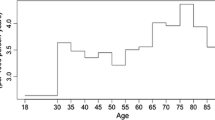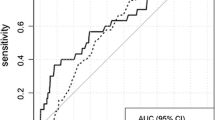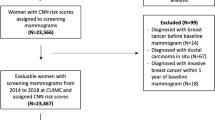Abstract
Purpose
Black breast cancer (BC) survivors have a higher risk of developing contralateral breast cancer (CBC) than Whites. Existing CBC risk prediction tools are developed based on mostly White women. To address this racial disparity, it is crucial to develop tools tailored for Black women to help them inform about their actual risk of CBC.
Methods
We propose an absolute risk prediction model, CBCRisk-Black, specifically for Black BC patients. It uses data on Black women from two sources: Breast Cancer Surveillance Consortium (BCSC) and Surveillance, Epidemiology, and End Results (SEER). First, a matched lasso logistic regression model for estimating relative risks (RR) is developed. Then, it is combined with relevant hazard rates and attributable risks to obtain absolute risks. Six-fold cross-validation is used to internally validate CBCRisk-Black. We also compare CBCRisk-Black with CBCRisk, an existing CBC risk prediction model.
Results
The RR model uses data from BCSC on 744 Black women (186 cases). CBCRisk-Black has four risk factors (RR compared to baseline): breast density (2.13 for heterogeneous/extremely dense), family history of BC (2.28 for yes), first BC tumor size (2.14 for T3/T4, 1.56 for TIS), and age at first diagnosis of BC (1.41 for < 40). The area under the receiver operating characteristic curve (AUC) for 3- and 5-year predictions are 0.72 and 0.65 for CBCRisk-Black while those are 0.65 and 0.60 for CBCRisk.
Conclusion
CBCRisk-Black may serve as a useful tool to clinicians in counseling Black BC patients by providing a more accurate and personalized CBC risk estimate.


Similar content being viewed by others
Explore related subjects
Discover the latest articles and news from researchers in related subjects, suggested using machine learning.Data availability
BCSC data can be requested at https://www.bcsc-research.org/. SEER data can be requested at https://seer.cancer.gov/.
Code availability
Software implementing CBCRisk-Black will be available at https://personal.utdallas.edu/~swati.biswas/.
References
Cancer Facts & Figures 2020. (2020). https://www.cancer.org/research/cancer-facts-statistics/all-cancer-facts-figures/cancer-facts-figures-2020.html. Accessed 27 July 2021
Race/Ethnicity. (2020). https://www.breastcancer.org/risk/factors/race_ethnicity. Accessed 30 Dec 2021
Gao X, Fisher SG, Emami B (2003) Risk of second primary cancer in the contralateral breast in women treated for early-stage breast cancer: a population-based study. Int J Radiat Oncol Biol Phys 56(4):1038–1045
Giannakeas V, Lim DW, Narod SA (2021) The risk of contralateral breast cancer: a SEER-based analysis. Br J Cancer 1–10
Watt GP, John EM, Bandera EV, Malone KE, Lynch CF, Palmer JR, Bernstein JL (2021) Race, ethnicity and risk of second primary contralateral breast cancer in the United States. Int J Cancer 148(11):2748–2758
Xiong Z, Yang L, Deng G, Huang X, Li X, Xie X, Wang X (2018) Patterns of occurrence and outcomes of contralateral breast cancer: analysis of SEER data. J Clin Med 7(6):133
Chowdhury M, Euhus D, Onega T, Biswas S, Choudhary PK (2017) A model for individualized risk prediction of contralateral breast cancer. Breast Cancer Res Treat 161(1):153–160
Gail MH, Brinton LA, Byar DP, Corle DK, Green SB, Schairer C, Mulvihill JJ (1989) Projecting individualized probabilities of developing breast cancer for white females who are being examined annually. J Natl Cancer Inst 81(24):1879–1886
Basu NN, Ross G, Evans D, Barr L (2015) The Manchester guidelines for contralateral risk-reducing mastectomy. World J Surg Oncol 13(1):1–6
Giardiello D, Steyerberg EW, Hauptmann M, Adank MA, Akdeniz D, Blomqvist C, Chang-Claude J (2019) Prediction and clinical utility of a contralateral breast cancer risk model. Breast Cancer Res 21(1):1–13
Chowdhury M, Euhus D, Arun B, Umbricht C, Biswas S, Choudhary P (2018) Validation of a personalized risk prediction model for contralateral breast cancer. Breast Cancer Res Treat 170(2):415–423
Giardiello D, Hauptmann M, Steyerberg EW, Adank MA, Akdeniz D, Blom JC, Brinkhuis M (2020) Prediction of contralateral breast cancer: external validation of risk calculators in 20 international cohorts. Breast Cancer Res Treat 181(2):423–434
Breast Cancer Surveillence Consortium. (2021). https://www.bcsc-research.org/. Accessed 27 July, 2021
Surveillance, Epidemiology, and End Results Program. (2021). https://seer.cancer.gov/. Accessed 27 July 2021
James G, Witten D, Hastie T, Tibshirani R (2013) An introduction to statistical learning with applications in R. Spinger.
Kattan MW, Gerds TA (2018) The index of prediction accuracy: an intuitive measure useful for evaluating risk prediction models. Diagnostic Prognostic Res 2(1):1–7
Reid S, Tibshirani R (2014) Regularization paths for conditional logistic regression: the clogitL1 package. J Statist Softwa 58(12)
Orom H, Kiviniemi MT, Shavers VL, Ross L, Underwood W (2013) Perceived risk for breast cancer and its relationship to mammography in Blacks, Hispanics, and Whites. J Behav Med 36(5):466–476
Acknowledgements
Data collection was supported in part by the National Cancer Institute-funded Breast Cancer Surveillance Consortium (HHSN261201100031C and P01CA154292). The collection of BCSC cancer and vital status data was supported in part by several state public health departments and cancer registries throughout the U.S. (http://www.bcsc-research.org/work/acknowledgement.html). All statements in this report, including its findings and conclusions, are solely those of the authors and do not necessarily represent the views of the National Cancer Institute or National Institutes of Health. We thank the participating women, mammography facilities, and radiologists for the data they have provided. You can learn more about the BCSC at: http://www.bcsc-research.org/. We thank the anonymous reviewers for their constructive comments and suggestions, which have led to an improved manuscript.
Funding
This project was partially funded by the National Cancer Institute at the National Institutes of Health (Grant Number R21 CA186086).
Author information
Authors and Affiliations
Corresponding authors
Ethics declarations
Conflict of interest
The author declare the that they have no conflict of interest.
Ethical approval
This study (secondary analysis) was approved by the University of Texas at Dallas IRB.
Consent to participate
Not applicable.
Consent for publication
Not applicable.
Additional information
Publisher's Note
Springer Nature remains neutral with regard to jurisdictional claims in published maps and institutional affiliations.
Supplementary Information
Below is the link to the electronic supplementary material.
Rights and permissions
About this article
Cite this article
Sajal, I.H., Chowdhury, M., Wang, T. et al. CBCRisk-Black: a personalized contralateral breast cancer risk prediction model for black women. Breast Cancer Res Treat 194, 179–186 (2022). https://doi.org/10.1007/s10549-022-06612-5
Received:
Accepted:
Published:
Issue Date:
DOI: https://doi.org/10.1007/s10549-022-06612-5




